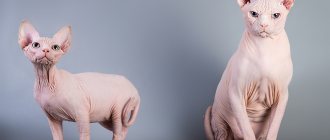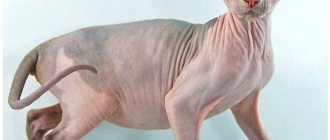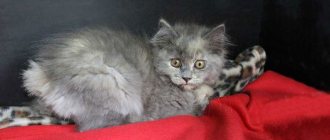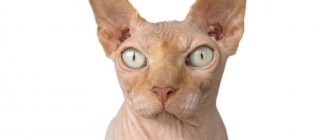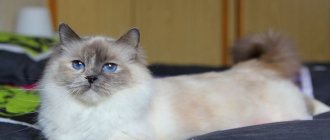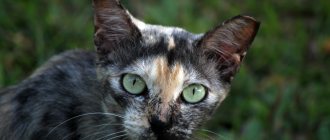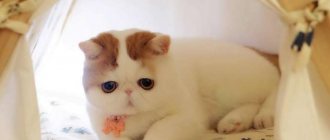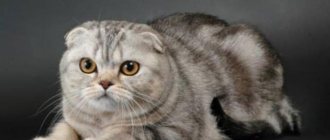Video
* We invite you to watch a video about the Sphinx . In fact, in front of you is a playlist in which you can select and watch any of 20 videos about a given cat breed by simply clicking on the button in the upper right corner of the window. In addition, the material contains quite a lot of photos. By looking at them you can find out what the Sphinx looks like.
In this article:
|
Reviews about the breed
If we analyze the reviews about Canadian Sphynx dogs left by owners, we can say with confidence that this breed is not for everyone.
By nature, Canadian Sphynxes are good-natured, sweet and playful, with rare exceptions. Due to lack of attention, improper upbringing and socialization, they can become aggressive, fearful or nervous.
The appearance of these cats is, to put it mildly, specific and not everyone will like it. For many, it is an unpleasant discovery that the secretions on the skin of sphinxes, called sweat, remain on clothes, beds and furniture.
Some representatives of the breed are absolutely not clean and after every trip to the toilet they literally have to wipe their butts.
Most often, sphinxes get along well with other pets, except for small rodents, birds and similar animals.
They often treat small children with tenderness and love.
Almost all the disadvantages of maintenance relate to care. Not everyone is ready for regular hygiene of eyes, ears and skin.
Without dividing into pros and cons, let's try to create a kind of composite image of the Canadian Sphynx based on its most striking qualities:
- good-natured and moderately calm cats;
- are very attached to the owner and friendly to all family members;
- require complex regular care;
- sensitive to living conditions, cannot tolerate drafts;
- exotic appearance;
- representatives of the breed are smart and quick-witted;
- they have no fur, so they do not cause a reaction in most allergy sufferers;
- Sphynxes have a fast metabolism, so they actually eat more than other cats and need only high-quality food;
- in summer you should make sure that they do not get sunburned;
- The breed is susceptible to many diseases, especially skin diseases.
History of the origin of the sphinxes
Sphynxes are one of the oldest cat breeds. There is evidence that they existed in ancient Egypt, when the white, blue-eyed sphinx guarded sacred places. The ancient Aztecs also had cats without hair; resourceful people used them as living hot water bottles.
Ancient breeds of hairless cats disappeared for various reasons, therefore, we can say that modern Sphynxes were bred artificially. For example, in the USA at the beginning of the 20th century, there was an exhibition where the Mexican hairless cat was shown - the closest relative of the ancient hairless cats. Unfortunately, the Mexican hairless disappeared completely by the thirties, because they could not leave productive offspring.
Hairless kittens can appear in furry cats, regardless of their breed. In 1938, biologist E. Letard from France began studying mutations that were observed in hairless kittens from a Siamese cat. In parallel, hairless cats had already been studied in Scandinavia and England, although these were only studies and not attempts to recreate the ancient breed.
The breed dates back to 1966, when another hairless kitten appeared in Canada from an ordinary domestic cat. The kitten was named Prune and was bred with its mother, resulting in both furry and hairless kittens. It was Prune who was crossed with his relatives in order to get as many hairless kittens as possible. However, the breed had not yet been formed, and the population was small. In addition, the kittens had weak immunity and often died.
The story of the Sphynx could have ended if in 1975 a hairless kitten had not appeared in Wadena from an ordinary short-haired cat. The kitten was ironically named Epidermis. Afterwards, a hairless cat was born there, and both individuals were placed in a nursery. This is how the Sphynx breed began - they successfully reproduced and gave birth to hairless kittens.
Canadian Sphynx (Sphynx) TICA standard
Sphynx head Size: medium. Shape: a modified wedge with rounded contours, the length of the head is slightly greater than its width. Skull: Slightly rounded with a fairly flat front. Profile: light to medium stop on the bridge of the nose. Cheekbones: pronounced. Muzzle and Chin: Strong, rounded muzzle with distinct whisker pads and a strong chin.
Neck Length: Medium. Shape: round, well muscled. Feature: slightly arched from the line of the shoulders to the base of the skull. Strong, especially in males.
Ears Shape: wide at the base and open. Size: very large. Posture: straight, sits neither too low nor too high on the head. Feature: the inner part is absolutely wool-free. A small amount of hair is allowed on the outside and at the outer base of the ears.
Eyes of the Canadian Sphynx Shape: rounded lemon-shaped. Size: large. Location: Extended towards the outer edge of the ears. The distance between the eyes is slightly larger than the size of the eye.
Eye color Ideally matches the color, but green and greenish-brown are allowed.
Body Size: Medium. Length: wide, can be barrel-shaped. Belly: rounded, giving the impression that the cat has eaten well, but not fat. Build: average. Musculature: well developed, not graceful.
Tail Shape: flexible and mobile, pointed from the body to the end (rat tail). Length: proportional to the body. Feature: A lion's tail (tuft of fur at the end) is allowed.
Legs of the Canadian Sphynx Length: proportional to the body. The hind legs are slightly longer than the front legs. The front legs are set wide apart. Build: average. Musculature: Strong, muscular body.
Feet Shape: oval with long graceful toes. Size: medium. Paw pads: Thicker than other breeds, giving the appearance that the cat is walking on cushions of air. Fingers: very long, graceful and developed.
Cover and skin Length: appearance of hairlessness. Can be covered with soft, fine down. May have a tuft of fur at the end of the tail
Disadvantages of the Canadian Sphynx Disadvantages: cats are too small. Too thin body, fragile or graceful build; too massive and rough body. Lack of folds on the head. Straight profile. Narrow head. Naughty character. Considerable amount of hair above the ankles.
Without awarding titles The presence of wavy hair is an assumption that the cat is a hairless Cornish or Devon Rex. Any signs of depilation, cutting, plucking or other hair removal procedures. Aggressiveness of the cat, which does not allow it to be picked up for judging.
SCORE: Head (35) - shape and size 5 - muzzle and chin 5 - profile 5 - cheekbones 5 - eyes 5 - ears 10 Body (35) - chest 10 - belly 10 - paws 5 - tail 5 - neck 5 Skin and cover (25) Color (5)
Total: 100 points
Cat breed - BAMBINO
Bambino is one of the youngest breeds, which appeared as a result of crossing the Canadian Sphynx and the Munchkin. The obvious difference between these cats is their short legs and large eyes. The Bambino's cartoonish appearance and very affectionate nature make it one of the most popular breeds in the world.
History of the breed.
It all started in Arkansas, USA. In 2005, the Osborne couple, owners of the Sphynx nursery, acquired a funny kitten with paws of non-standard length. The new pet was named Bambino, which translated from Italian means “baby”, “child”. The name became the name of the breed and remains to this day. A married couple decided to increase the number of a new type of cat. Bambino were presented to the public already in 2006.
A funny coincidence - at the same time, Russian breeders Elena and Maria Chernov were breeding a breed that had the genes of the Canadian Sphynx, Munchkin, Devon Rex and Burmese. The kittens obtained as a result of selection were called Minskins. Representatives of this breed, unlike bambinos, have hair on their paws, back, muzzle and tail, and their belly remains hairless; you must keep this fact in mind when purchasing a bambino.
Features of the breed.
Appearance:
Weight: 2-3 kg (females), 2.5-4 kg (males).
Approximate growth of bambino cats by month:
| age, months | female weight | male weight |
| 1 | 240-400 g | 300-500 g |
| 2 | 500-750 g | 500-900 g |
| 3 | 1-1.8 kg | 1.3-2.4 kg |
| 4 | 1.3-2 kg | 1.5-2.8 kg |
| 5 | 1.4-2.1 kg | 1.7-3 kg |
| 6 | 1.5-2.2 kg | 1.8-3.2 kg |
| 8 | 1.7-2.5 kg | 2-3.3 kg |
| 10 | 1.8-2.7 kg | 2.1-3.6 kg |
| 12 | 1.9-2.8 kg | 2.3-3.8 kg |
| 18 | 2-3 kg | 2.5-4 kg |
Height at withers: 10-20 cm.
Skin: hair is practically absent, folds are located on the body and head. The standard allows a small amount of fluff, mainly on the muzzle, exactly the same as that of the Canadian Sphynx.
Head: medium size, wedge-shaped. The cheekbones are prominent, the jawline is well defined.
Nose: straight.
Eyes: wide, lemon-shaped. Colors – blue, green, yellow. Divergence of eyes (heterochromia) is allowed.
Ears: large, wide at the base.
Body: elongated, stocky, very strong in appearance. The chest is wide.
Tail: thin and long...
Limbs: short, muscular. The hind legs are slightly shorter than the front legs.
Color: any shades.
Sphinx - description of the breed
In fact, sphinxes are not completely devoid of fur: their skin is soft and velvety to the touch. The Sphynx's fur is so short that it is almost invisible. Some Sphynx breeds have some hair on their face or paws, although most Sphynx breeds appear completely hairless. Also, these cats do not have whiskers.
Today there are three generally recognized breeds of Sphynx, which are registered by the Association of Cat Fanciers.
These include:
- Canadian Sphynx. This breed has been around for 60 years. The body of the Canadian Sphynx has inconspicuous fluff and many folds of leather. They have large expressive eyes and large ears. The body is smaller in size than that of a normal cat;
- The Don Sphynx was bred in Rostov-on-Don. They are quite large and have a lot of folds. The body is more massive and short - they are very reminiscent of an ordinary domestic cat without hair. Sometimes a small amount of soft fluff is allowed on the bodies of Don Sphynxes, which curls into curls;
- The Peterbald or Petersburg Sphynx is a breed obtained by crossing with graceful Oriental cats. Thanks to this tandem, the breed turned out to be very elegant: an elongated head, narrow eyes and long ears. The body is refined, elongated. Peterbalds may have a small, smooth coat.
The Sphynx cat continues to change and improve. So far, the most popular and stable are the Canadian Sphynxes. All sphinxes have well-developed muscles, which makes them, even with all their elegance, quite strong animals. The tails of sphinxes are also completely devoid of hair, and are always slightly curled into a spiral at the end.
Canadian Sphynx (Sphynx) WCF standard
Body
Medium size, muscular, round, strong. At the same time, the skeleton is relatively elegant. The chest is wide, massive, the belly is rounded. The limbs also have a graceful structure, but the muscles are strong. The front legs are set wide due to the wide chest. Paws are oval, with long toes. The tail is long, thin, whip-shaped, without hair, but a tassel at the tip is allowed (lion tail).
Head : Medium size, slightly rounded modified wedge, not much longer than wide, with prominent cheekbones and a short, powerful, well-defined muzzle. Profile with transition. The neck is of medium length and muscular.
Ears: Very large, set wide apart, wide at the base, completely devoid of brushes. Slight pubescence at the base of the outer side of the ear is acceptable.
Eyes Large, lemon-shaped, set at a slight angle. The distance between them is slightly greater than the width of the eye. Eye color should be in harmony with skin color.
Wool The skin should have only minimal invisible fluff; it looks like the skin of a child. There is short pubescence on the muzzle; whiskers are desirable. The skin is clean, there are folds on the forehead, neck and limbs.
Color All colors are accepted, description is in the list of colors.
Disadvantages: Too much resemblance to both the Devon Rex and the Cornish Rex is a serious disadvantage.
Note: Crossing with other hairless breeds is prohibited.
SCORE:
body 35 head 30 eyes 5 hairless, folded 25 condition 5
total 100
Popular Sphynx colors
Sphynx cats come in a variety of colors, many of which differ from standard cat colors.
In general, cat colors are classified as follows:
- Solid - the color of the cat's body is uniformly one color from the whiskers to the tip of the tail. The color is necessarily intense;
- Tortoiseshell - a combination of several colors, in particular black and red. There are no strict requirements for tortoiseshell colors, since during selection they are modified in every possible way;
- Tabbies are striped, spotted and marbled cats, in which a contrasting pattern is clearly visible;
- Bicolors - a combination of white and primary colors;
- Colored cats are the color of Siamese cats.
In particular, the following colors are available for Sphynxes of various breeds:
- Classic: white, black, blue, red, cream, chocolate;
- Lilac – gray with a pinkish tint. The nose and paws remain bright pink;
- Cinnamon – brown color;
- Background – pale pink color;
- Classic tabby - with markings on the paws and tail, curls on the cheeks. Original color with many markings consisting of lines and spots;
- Mackerel - the legs are colored in rings that smoothly turn into markings throughout the body;
- Spotted tabby - markings on the body in the form of spots;
- Thorby is a tortoiseshell color that combines silver, blue, red and other colors;
- Silver, brown, blue, red, cream tabby;
- Calico - aka chintz. White color with pale black and red spots;
- Van Calico - white with blue and cream spots;
- Point - a color in which numerous points of different colors are located on the body of the sphinx;
- Sable – brown color without any markings;
- Platinum is a honey-beige color of a cat.
Character and habits of sphinxes
Sphynx cats really need human interaction, and this distinguishes them from many other cat breeds. They are loving, love to sit on laps, and enjoy being petted. The Sphynx does not like to be alone for a long time, so these cats are not suitable for people who are always busy at work.
Sphinxes are completely non-aggressive, friendly and friendly. They are ready to meet new people, willingly allow themselves to be petted and prefer not to show aggression. These cats are well suited for families with children, as they love to play and will never offend a person. You can choose to overcome obstacles as games with sphinxes - these cats are excellent at learning.
Interesting fact: Sphinxes do not have a tendency towards vengeance, and they are not at all vindictive. At the same time, sphinxes are extremely vulnerable animals, so you should treat them kindly and friendly. You should not yell at them, much less hit them, as this can make the cat depressed. Sphinxes easily get psychological trauma, which is why their life expectancy is reduced.
Sphinxes are very curious. They love to climb into inaccessible places in the house and always pay attention to new objects. Therefore, they should hide prickly and cutting things, since curious cats will definitely get to them.
The Sphinx will never perceive itself as inferior to a person. Only partnerships are possible with these cats, in which the sphinx is a full-fledged member of the family. Because of this, you should not expect that the Sphinx will unquestioningly obey and carry out commands. Therefore, it is generally accepted that these cats are characterized by stubbornness and pride.
Sphynxes get along well with other animals, they are not even afraid of dogs. At the same time, the sphinx will not be jealous of the owner of other pets if they devote enough time to everyone.
How to educate correctly?
In the process of developing and shaping the character of a hairless cat, you need to take into account the characteristics of his psyche in order to raise an obedient and healthy member of your family. Learn to trust each other and you will succeed.
What to do about bad behavior?
He absolutely does not perceive rudeness. He may only become offended or become even more agitated, so it is necessary to punish carefully. If your baby climbs into prohibited places or scratches the wallpaper, use a spray bottle. Fill it with warm water, spraying your pet with a thin stream every time he tries to play pranks. Be careful not to get it in your eyes or ears.
Talk to him. Animals perfectly understand strict and confident intonation. There is no need to shout - it’s still useless. Try to distract the prankster with a new toy or interesting activity, switch his attention. It's a win-win. In adolescence - at 7-8 months, attempts will begin to establish their dominance over you or their own rules. Biting your hand or attacking your heels will become a common occurrence. Determine in advance what is acceptable for the kitten. What he is allowed to do now, he will do in adulthood.
Ways to encourage
Don't forget to praise your friend for being calm during nail trimming or bathing, and for being obedient. Stroke him on the head and back, say kind words. Be sure to give a treat - a piece of meat or cheese. Then the baby will learn that good behavior is pleasantly rewarded.
The Sphinx chooses its own leader in the family, to whom it will obey. This must be a person with a stable psyche and strong willpower. The pet will treat everyone else as his friends. Don't let the animal manipulate you, otherwise it will become a habit. Look for compromises and set your own rules without giving in to provocations.
Sphinxes are incredible creatures. They will always feel sorry for you if you feel bad. They love company and are always ready to establish contact with those who like them. These are true friends for creative, energetic and kind people. Unpretentious cats will not take up much of your time; caring for them is quite simple.
Interesting facts about sphinxes
Contrary to popular belief, Sphynx cats are an ancient breed of cat, but this is not entirely true. Ancient hairless cats became extinct for various reasons, and sphinxes are an artificially bred breed that was created due to mutations.
Typically, Sphynx cats live for about 14 years. The longest living cat of this breed died at the age of 19 years. The key to success in the longevity of these cats is proper care and a minimum of stress.
Sphynxes are very hot animals, as their body temperature reaches 39 degrees Celsius. It was not for nothing that the ancient Aztecs used sphinxes as living hot water bottles. Given their temperature, cats of this breed are extremely heat-loving and cannot tolerate cold weather.
Sphynx cats are suitable for people who really want to have a cat, but are allergic to fur. The absence of hair is also a plus in caring for a pet. Sphynxes love to swim in warm water.
Newborn Sphynx cats have drooping ears, and their body is covered from head to toe with folds, some of which straighten out with age.
Hairless cats were considered sacred in many nations. Their gracefulness was glorified in antiquity, and the cult of cats in ancient Egypt did not bypass the oldest representatives of hairless cats.
Sometimes sphinxes do show aggression, but this is not the norm for their behavior. Aggressive sphinxes are cats that have suffered some kind of stress or received psychological trauma. Such cats should be gradually rehabilitated, but trust will be extremely difficult to restore.
Sphynx cats have very sensitive skin. They should definitely be stroked and scratched, as this gives them pleasure, makes them happy and even more attached to their owner.
Canadian Sphynx (Sphynx) CFA Standard
The Canadian Sphynx breed standard, adopted as final for judging under the CFA system (with the award of champion status), starting on May 1, 2002. The abbreviation adopted for this breed is SPH (SPX).
General Description The most significant difference between these cats is the appearance of hairlessness. Sphynx cats are medium sized and built with a surprisingly heavy weight for their size. Sexual demorphism is pronounced, i.e. cats are on average smaller than males.
The shape of the head is a modified wedge with pronounced cheekbones and whiskers, giving the muzzle (that is, the part of the head, starting from the bridge of the nose and ending with the chin) a “squared” appearance. The body is warm and soft to the touch, with a texture similar to a soft peach or smooth nectarine. Canadian Sphynxes have a sweet character, loving, intelligent and sociable, very sociable.
Head The length of the head is slightly greater than its width, with prominent cheekbones and a distinct “pinch” (the line of transition from the cheekbones to the muzzle with a noticeable “interception”). The skull is slightly rounded with a flat area in front of the ears. The nose is straight, with a slight or moderate palpable stop (a “dimple” or “hollow” should be clearly defined at the transition point from the forehead to the nose).
Cheeks and Cheekbones Pronounced, rounded arches of the cheekbones, outlining the eye sockets and running in convex curves above the “pinch”.
Pinch muzzle and chin A strong, well-developed chin forms a perpendicular line with the upper lip.
Neck The neck is of medium length, rounded, well muscled, slightly arched. Strong muscles are acceptable in adult cats.
Ears are large to very large. Wide at the base, open and erect. When viewed from the front, the outer edge of the base of the ear should be in line with the line of the eyes, and their position should be neither low nor too high. The inside of the ears is without hair.
Eyes Large, lemon shaped (wide in the middle and tapering at the edges). Set slightly slanting (outer edge higher than inner), in line with the outer base of the ear. Set wide apart, the distance between them is at least equal to the size of the eye. Eye color can be any.
Body The body is of medium length, heavy and muscular, with a wide, rounded chest and a full, rounded belly. The croup area is also rounded and muscular. The line of the back rises just behind the shoulder blades due to the greater length of the hind legs, which can be seen when the animal is standing. Build type: average.
Paws Paws are medium, proportional to the body. Strong, muscular, hind legs longer than the front. The paws are like handles, oval in shape, with well-developed long, jointed fingers. The pads of the fingers are thick, giving the impression that the cat is standing on thick pillows.
Tail Graceful, flexible and long tail. The length is proportional to the body. “Rat”, tapering towards the end.
Cover and skin Visibility of hairlessness. Short, fine hairs may be present on the paws, outside of the ears, tail, and scrotum. The bridge of the nose should be covered with normal hair. On other parts of the body, the cover can vary from complete hairlessness to soft peach-like fluff no more than 2 mm long. This texture of the skin is felt when stroking, creating the impression of suede or velor. The skin is thick and folded, especially around the muzzle, between the ears and around the shoulders. The vibris are either absent or short, crimped and broken off.
Colour, Colour: Color quality and coat type are difficult to judge and should not influence the judging of Sphynx cats. White markings and spots are permitted. All colors are recognized, with the exception of those determined by the zonation of hair coloring (smoke, cameo, chinchilla, etc.). Sunbathing leads to an increase in the intensity of any colors.
The disadvantages of Wool are more than described above. Too thin body, fragile or graceful build. Straight profile. Narrow head. The type of the Canadian Sphynx should not be similar to the Devonian, Cornish, or Oriental. Naughty character.
No awards
Hooked, curved tail. Structural violations. Aggressiveness of the cat, which does not allow it to be picked up for judging.
SCORE:
HEAD 35 points BODY 35 points shape and size 5 points chest 10 points muzzle and chin 5 points belly 10 points profile 5 points paws 5 points cheekbones 5 points tail 5 points eyes 5 points neck 5 points ears 10 points SKIN AND COVER 30 points
TOTAL : 100 points
Pros and cons of sphinxes
The most obvious advantage of Sphynx cats is the lack of hair. Cats do not cause allergies, they do not need to be combed, and the hair that falls out does not settle on clothes, furniture or the floor. Like fluffy cats, Sphynx cats are pleasant to the touch and love affection in the same way.
Sphynxes are affectionate and loving – this is also a plus for ardent cat lovers. Sphinxes will always be happy to be stroked and will never refuse to sit on their owner’s lap. They love to sleep with people under a blanket and, moreover, sphinxes are very warm, so they can even warm their owner.
Fun fact: Sphynx cats are smart and easy to train. They will be happy to perform simple tricks if you handle the animal correctly. They usually willingly make contact with people who have always been respectful to them.
Sphynx cats love to play, so they can be kept in families with children. They also get along easily with other animals. Sphynx cats are in good health, although regular check-ups by veterinarians should not be neglected.
Sphynx kittens are born strong and healthy and quickly open their eyes. Sometimes little sphinxes are born sighted. Also, since childhood, they have a good appetite and willingly eat both homemade food and feed.
Sphinxes also have negative sides. The most basic of them is that cats sweat a lot. The fact is that in ordinary cats all the sweat is absorbed into the undercoat and evaporates, but Sphynx cats do not have such an undercoat. Their sweat has an odor and an unpleasant brown tint. If a cat sweats while sitting on light-colored furniture or clothing, the stain will certainly remain. Such stains are almost impossible to remove.
Sphynxes are playful and curious, and if they are not provided with the necessary toys, they will find them themselves: they will rip curtains, eat pins and do other unpleasant things. Sphynx cats are also clean, so they won’t want to visit a litter box that already has a strong smell.
Choice of kitten and price
After making the final decision to purchase a Sphynx, you need to choose a qualified breeder. You can, of course, buy kittens without documents, “from your hands,” but such animals are often born from accidental mating. This means that no one gives guarantees of health or further support. In addition, there is a possibility that the babies are not purebred and were the result of an accidental mating with another breed. When choosing a kitten, it is important to look at its parents, their merits and living conditions.
Considering the uniqueness of the breed, the price of Sphynx kittens is quite high. If you take a kitten from a nursery, a pet-class baby will cost an average of $500. Animals with exhibition prospects, as well as for breeding, can cost significantly more.
Hand-picked kittens without documents cost an average of 3-5 thousand rubles.
You can take your baby to a new home only after routine vaccination and deworming at the age of 3 months. Such babies are already socialized, accustomed to a tray, scratching post and certain food. They are less likely to have behavior problems.
Breeding Sphynxes
Reproduction of Sphynx cats requires special attention, and breeding of cats of this breed should only be done by people who already have experience in breeding cats. It is important to know how Sphynx puberty proceeds, how to choose a partner for mating and how to deliver a cat so that everything goes well.
Cats mature around the seventh month of life, but it is still too early to start breeding them. It is important to wait out the first heat: the sphinx begins to scream and fuss. Changes occur in its behavior: cats can become both very affectionate and aggressive. The Sphynx's body is still developing, so you should just wait out this period if you are not going to sterilize the cat.
Males mature around the eighth month of life. They are not yet ready for mating - readiness can also be understood by a change in behavior: the pet is actively marking its territory and becoming aggressive.
The first mating can be carried out after the cats are one and a half years old - during this time the cat goes through at least three heats. By this age, animals must be fully vaccinated and healthy, otherwise there is a risk of getting sick offspring. Cats cannot be vaccinated after mating.
Before mating, animals must be checked by veterinarians to ensure that there are no accidental diseases. Before mating, the animals' claws are trimmed so that they do not accidentally fight. It is better to give the cats time to get used to each other a little and get to know each other. The smell of the cat should attract the male, so everything will go naturally. Sometimes mating alone is not enough, so cats must spend several days with each other.
Pregnant cats become lazy and affectionate. Pregnancy lasts 63 days, but delayed births are not uncommon among this cat breed. Sphynx cats usually give birth on their own without complications. In general, a cat can bear up to 12 healthy kittens. Kittens are born healthy and strong, and open their eyes very early.
Sphynx care
First of all, care concerns the skin of sphinxes. Since cats sweat profusely, they need to be washed and wiped with wet wipes. A crust may even appear on unkempt skin, which can cause dermatitis.
When bathing sphinxes, you should follow the following rules:
- The water temperature should not exceed 38 degrees;
- If you are bathing a kitten, you should lower it into the water slowly. It is worth placing a rubber mat on the bottom to prevent it from slipping;
- You should only use special shampoo for sphinxes;
- The towel you wrap your Sphynx in should be soft and terry, as other material may irritate the skin;
- You need to hold a wet Sphynx in your arms until it is completely dry, otherwise the animal will catch a cold;
- Under no circumstances should you dry it with a hairdryer;
- You can use a special moisturizer to soften your skin after swimming.
Sphynxes are bathed once a week, but every day it is worth wiping them with special napkins and dry towels so that sweat does not accumulate on them.
It is worth understanding that sphinxes do not have any protection, which fluffy cats have. Therefore, their ears should be cleaned regularly with chopsticks to prevent wax from accumulating in them. Sphynx teeth should also be cleaned of dirt with special pastes.
The lack of eyelashes also makes Sphynx cats vulnerable to dust and dirt. It is worth regularly cleaning the corners of the eyes with cotton swabs, and also having your cat examined by a veterinarian for eye diseases.
Since Sphynx cats are not protected from the sun's rays, they can get sunburned. It is worth monitoring how long cats lie in the sun so that they do not get burned. Burns should be treated with special ointments.
Big ears
The peculiarity of the ears of the Canadian Sphynx lies in their size, which can be not just large, but very large. Quite wide at the base, the Sphynx's ears have a geometric feature and a special feature of the breed - along the outer edge they should coincide with the line of the eyes. It is difficult to imagine that any part of the Sphynx's body has abundant hair, which is why the inside of the ears does not have hair.
Sphynx diet
Sphynxes are unpretentious in food and do not require a special selection of diet. Of course, if this is ready-made food, then preference should be given only to premium food. Little kittens feed on their mother's milk for up to one and a half months, which provides them with everything they need. At two months, kittens should be given special supplements or ground boiled chicken breast, beef, or chicken egg yolk. Ready-made food is pre-soaked in water.
After the kitten is taken from the nursery, it is worth feeding it the same food that the breeder fed it. This will minimize the stress the kitten experiences when separated from its mother. Nutrition according to the new scheme should be introduced gradually a week after weaning.
In no case should you feed Sphynxes food from the table - they are prone to overeating and are ready to eat even what cats do not eat in principle. Although hairless cats do eat more than fluffy ones, since they spend much more energy on keeping warm. For example, a two-month-old kitten is fed up to eight times a day, so it is necessary to feed even at night.
If you are choosing homemade food for your pet, then it must include the following components:
- Daily – beef, rabbit, poultry (alternate);
- Boiled offal several times a week;
- Cereals such as corn, wheat, rice or buckwheat;
- Egg once a week;
- Carrots, zucchini, broccoli, cabbage and other greens up to three times a week;
- Daily vitamin supplements.
The best option would be to make a piece of minced meat, add an egg and vegetables to it, and also add a few drops of vitamin D - healthy food for your pet is ready.
Personality Traits of Canadian Hairless Cats
Sphynx cats have a very kind, patient character and good attitude towards dogs. These cats can be left alone with children without worrying about both of them. They are not jealous, very patient and smart. Sphinxes often choose their favorite owner or even guest.
Male Sphynx cats tend to be dominant. They consider themselves masters of the house, independent and very curious. Any event does not pass by, any thing will be studied. Cats are softer and more gentle. They easily gain the trust and love of their owner. But the females need more attention to themselves and do not let you forget about their person: they will chase you and lick your face until they get tired. Female sphinxes are great lovers of cleanliness. They can lick themselves for hours. The completed washing procedure can be repeated after 2–3 hours.
Many people think that Canadians are very aggressive. But this is a mistaken opinion. My parents have a Canadian Sphynx. And he is very friendly, active and not afraid of strangers. Sphinxes have developed intelligence.
You can leave the Canadian Sphynx with the child
Positive qualities and disadvantages of the breed
Like any animal, the Canadian Sphynx has both positive and negative properties.
The positive qualities include the fact that they:
- playful;
- active;
- curious;
- tender;
- affectionate to the owner;
- get along well with other animals;
- patient;
- smart;
- love children.
And the negative qualities are as follows:
- they need daily care and frequent bathing;
- afraid of the cold;
- may seem intrusive.
Video: interesting facts about the Canadian Sphynx
Diseases and health problems
Sphynxes have a very strong immune system, so with proper care they will not catch colds or suffer from infectious diseases. But these animals have a number of birth defects that can manifest themselves in one form or another.
For example, the so-called “carp bite”, in which the lower jaw of the sphinx is slightly shortened. Cats' incisors do not touch, the jaw becomes warped, and tooth asymmetry occurs. Due to the fact that the teeth dig into the hard palate, ulcers and wounds constantly appear on it.
There is also a disease called microphthalmia, in which kittens’ eyes develop incorrectly, causing them to decrease in size. This is fraught with many eye diseases that need to be monitored by a veterinarian. Sometimes cysts and tumors appear in the eyes. A similar disease is entropion of the eyelids, which causes animals to suffer from conjunctivitis for life.
Important fact: Curvature of the caudal spine is also not a rare occurrence among sphinxes. Often kittens are simply born non-viable and die early. This disease is fraught with intestinal abnormalities, a weak digestive system, short stature and underdeveloped thoracic region.
Nipple hyperplasia occurs among female Sphynx cats and is inherited. It usually affects cats with light blue or blue-cream skin and blue eyes. It is impossible to diagnose it immediately, but it appears gradually. At the age of one year, kittens' nipples turn red, and the skin around them gradually thickens. Cysts may appear.
Cats with this disease should not be bred. Cubs can be born with pathological internal organs, which is why they often die. These cats also produce very little milk. Hyperplasia can occur if a cat is given hormones that suppress sexual desire.
Content
There is an opinion that Canadian sphinxes need to be kept in “greenhouse” conditions, but they are a little exaggerated. These cats are truly heat-loving cats, but feel fine at normal room temperatures. If it gets colder, you can dress them “according to the weather.” What Sphynx cats don't like is drafts. Toys and installation of a play complex will help provide them with an active pastime.
Nabbies prefer to sleep in a secluded place, so they often like various cat houses.
Walking outside is possible, but only in the warm season in calm weather and, of course, after all the necessary vaccinations. Usually Sphynxes are taught to walk on a harness. Free-ranging is dangerous due to their lack of necessary skills for street life and proper immunity.
